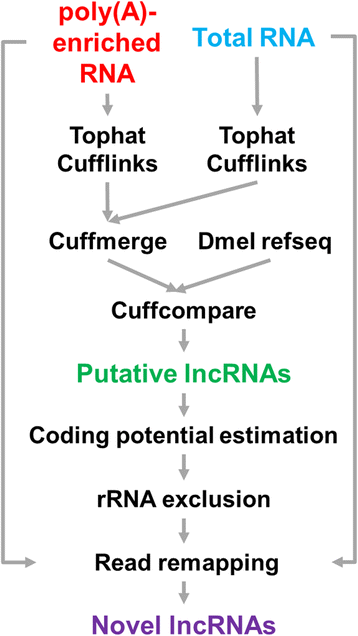Integrating RNA-seq and ChIP-seq data to characterize long non-coding RNAs in Drosophila melanogaster
- PMID: 26969372
- PMCID: PMC4787191
- DOI: 10.1186/s12864-016-2457-0
Integrating RNA-seq and ChIP-seq data to characterize long non-coding RNAs in Drosophila melanogaster
Abstract
Background: Recent advances in sequencing technology have opened a new era in RNA studies. Novel types of RNAs such as long non-coding RNAs (lncRNAs) have been discovered by transcriptomic sequencing and some lncRNAs have been found to play essential roles in biological processes. However, only limited information is available for lncRNAs in Drosophila melanogaster, an important model organism. Therefore, the characterization of lncRNAs and identification of new lncRNAs in D. melanogaster is an important area of research. Moreover, there is an increasing interest in the use of ChIP-seq data (H3K4me3, H3K36me3 and Pol II) to detect signatures of active transcription for reported lncRNAs.
Results: We have developed a computational approach to identify new lncRNAs from two tissue-specific RNA-seq datasets using the poly(A)-enriched and the ribo-zero method, respectively. In our results, we identified 462 novel lncRNA transcripts, which we combined with 4137 previously published lncRNA transcripts into a curated dataset. We then utilized 61 RNA-seq and 32 ChIP-seq datasets to improve the annotation of the curated lncRNAs with regards to transcriptional direction, exon regions, classification, expression in the brain, possession of a poly(A) tail, and presence of conventional chromatin signatures. Furthermore, we used 30 time-course RNA-seq datasets and 32 ChIP-seq datasets to investigate whether the lncRNAs reported by RNA-seq have active transcription signatures. The results showed that more than half of the reported lncRNAs did not have chromatin signatures related to active transcription. To clarify this issue, we conducted RT-qPCR experiments and found that ~95.24% of the selected lncRNAs were truly transcribed, regardless of whether they were associated with active chromatin signatures or not.
Conclusions: In this study, we discovered a large number of novel lncRNAs, which suggests that many remain to be identified in D. melanogaster. For the lncRNAs that are known, we improved their characterization by integrating a large number of sequencing datasets (93 sets in total) from multiple sources (lncRNAs, RNA-seq and ChIP-seq). The RT-qPCR experiments demonstrated that RNA-seq is a reliable platform to discover lncRNAs. This set of curated lncRNAs with improved annotations can serve as an important resource for investigating the function of lncRNAs in D. melanogaster.
Keywords: Active transcription; ChIP-seq; Drosophila melanogaster; Long non-coding RNA; RNA-seq.
Figures







References
Publication types
MeSH terms
Substances
LinkOut - more resources
Full Text Sources
Other Literature Sources
Molecular Biology Databases

